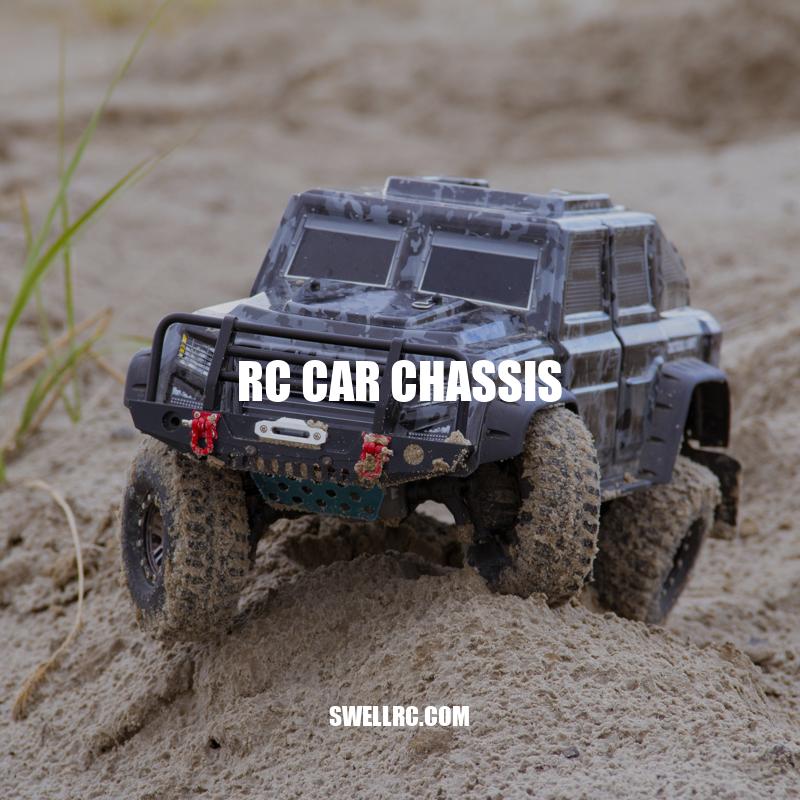RC Car Chassis: Choosing the Right Type for Peak Performance
RC Car Chassis: Understanding the Heart of Your Remote-Controlled Vehicle
Remote-controlled (RC) cars have always been fascinating to hobbyists and enthusiasts alike. Whether you’re a seasoned racer or a beginner, RC cars provide an exciting and thrilling experience like no other. However, if you want to take your RC racing game to the next level, you need to understand the most crucial aspect of any remote-controlled vehicle: the chassis. The chassis is the essential component that holds all the essential parts together, including the battery, electronics, motor, suspension system, and wheels. Therefore, selecting the right chassis is vital to achieving the speed, handling, and stability you want in an RC car. This article examines the various facets of RC car chassis to help you choose the right one for your next racing adventure. We’ll cover the different types of chassis available, their features, the critical factors to consider when selecting one, and some auxiliary components that could upgrade your RC car’s performance. So, whether you’re looking for more speed, better handling, or just want to have fun with RC racing, let’s dive deep into the heart of your remote-controlled vehicle: the chassis. Keywords: RC cars, hobbyists, enthusiasts, chassis, batteries, electronics, motor, suspension system, wheels, speed, handling.
Types of RC Car Chassis
Flat or Tub Chassis
- Most common type of chassis on RC cars
- Provides stability, consistency, and versatility
- Great for beginners due to ease of assembly
- Works well on different terrains, including dirt, asphalt, and carpet
LCG (Low Center of Gravity) Chassis
- Provides better handling and maneuverability due to lower center of gravity
- Great for high-speed racing and tight corners
- Preferred by experienced racers for its performance and speed
- Works better on smooth terrains such as asphalt and carpet
Mid-Motor Chassis
- Designed for high-performance racing with exceptional speed and acceleration
- Offers better weight distribution and balance due to the placement of the motor
- Provides better handling and stability on bumpy terrains
- Suitable for experienced racers due to its complexity and higher cost
When it comes to RC car chassis, you can find a wide array of options in the market with different features, functions and compatibility levels. Flat or tub chassis, LCG or Low Center of Gravity chassis and mid-motor chassis are some of the most common types of RC car chassis. Each type has its advantages and disadvantages, depending on your skill level and the terrain you’ll be racing. Additionally, some models and brands may specialize in certain types of chassis, so it’s important to research and compare products before making a purchase. RC racing communities and online hobbyist forums, as well as online platform for RC racing enthusiasts like Horizon hobby can help in exploring the available options.
What are the types of chassis?
There are four main types of chassis: ladder frame, backbone, monocoque, and tubular chassis. Ladder frame chassis is one of the oldest types and is still used today in many trucks and SUVs. The backbone chassis is commonly used in small and mid-sized cars. Monocoque chassis is used in high-performance vehicles and offers greater strength and rigidity. Tubular chassis is typically used in racing cars and offers excellent weight savings and handling characteristics. For more information on chassis types and their applications, you can check out car manufacturer websites such as Toyota, Honda, and Ferrari.
Selecting the Right RC Car Chassis
Factors to Consider
When selecting an RC car chassis, there are several factors to consider that will help you choose the one that best suits your needs:
- Type of vehicle: Consider the type of vehicle you have, such as a touring car, buggy, or truck, as well as its size and weight.
- Terrain: Determine the type of terrain you’ll be driving on—dirt, asphalt, or carpet—and choose a chassis best suited for that terrain.
- Skill level: Consider your skill level as a driver. Some chassis types require more advanced driving skills than others.
- Budget: Finally, consider your budget and how much you’re willing to spend on a chassis and any additional components or upgrades.
Chassis Compatibility Table
When choosing an RC car chassis, it’s essential to ensure it’s compatible with your vehicle and other components. Below is a table of popular RC car brands and models with recommended chassis types and compatibility levels:
| Brand/Model | Recommended Chassis Type | Compatibility Level |
|---|---|---|
| Traxxas Slash | Flat or LCG | High |
| Team Associated B6 | LCG or Mid-Motor | High |
| Tamiya TT-02 | Flat or LCG | Medium |
| HPI Racing Trophy Buggy | LCG or Mid-Motor | Medium |
| Losi TENACITY DB | LCG or Mid-Motor | Low |
It’s crucial to do your research and make an informed decision when selecting an RC car chassis. Familiarize yourself with the different types of chassis, consider the factors mentioned above, and compare brands and models before making a purchase. Additionally, consult with hobbyist communities and user forums, such as RC Groups, to get opinions and recommendations from experienced racers.
How do I choose the best RC car?
When choosing the best RC car, consider the type of vehicle (on-road or off-road), size, power source (battery or fuel), and control system. Look for models with durable construction and good customer reviews. Research online and read reviews on websites such as Amazon or RC car enthusiast forums to find the best options. You can also visit local hobby shops and ask for recommendations based on your needs and budget.
The Suspension System: A Critical Component of an RC Car Chassis
Types of Suspension Systems
The suspension system is a critical component that affects how well an RC car handles and the speed at which it can travel. When choosing an RC car chassis, it’s crucial to consider the suspension system type and its impact on your racing experience. The two most common types of suspension systems for RC cars are:
- Independent Suspension Systems: Independent suspension systems allow each wheel to move separately, which provides better handling, maneuverability, and stability at high speeds. This type of suspension is typically used for off-road vehicles, buggies, and touring cars.
- Dependent Suspension Systems: Dependent suspension systems are designed to allow the wheels to move together, enabling the car to maintain its balance, stability, and consistent traction in rough terrain. This type of suspension is typically used for on-road vehicles, such as sedans or touring cars.
Upgrading Your Suspension System
You can upgrade your RC car’s suspension system with various components to improve its handling, speed, and maneuverability. Some of the most popular suspension system upgrades include:
- Aluminum shock absorbers: Aluminum shock absorbers are more durable and reliable than plastic ones and provide better suspension tuning options.
- Stiffer or softer shock springs: Changing your shock springs can improve your vehicle’s traction on different types of terrain and enhance its handling and stability.
- Carbon fiber suspension arms: Carbon fiber suspension arms are lighter and more durable than plastic ones, ensuring better handling and longer-lasting performance.
Importance of the Suspension System
The suspension system is an essential component that affects your RC car’s performance, handling, and durability. A poorly designed or inadequate suspension system can cause your vehicle to be unstable, tip over, or crash, affecting your racing experience. Alternatively, a well-designed suspension system can help you improve your lap times, cornering speeds, and overall performance. Therefore, it’s crucial to consider all aspects of the suspension system when choosing an RC car chassis.
You can find a range of RC car chassis and suspension system components from hobbyist retailers and online marketplaces, such as AMain Hobbies and Amazon. When selecting suspension upgrades, ensure that they are compatible with your chassis and other components to avoid complications and reduce the risk of damage.
Which suspension system is best?
Twin-tube shocks are considered the best suspension system for comfortable daily driving, as they offer improved handling and control characteristics. This design is widely used in cars, light trucks, vans, and SUVs.
Choosing the Right Chassis for Your RC Car
Factors to Consider
When choosing the right RC car chassis, there are several factors to consider. These factors include:
- The type of terrain you’ll be driving on: Different terrains require different types of RC car chassis. For example, flat or tub chassis work well on indoor carpet tracks, while LCG or mid-motor chassis are ideal for outdoor dirt tracks.
- Your skill level as a driver: If you’re a beginner, you may want to start with a more straightforward, stable, and predictable chassis, such as flat or tub ones. Advanced drivers, on the other hand, may opt for more complex chassis types, such as LCG or mid-motor, to achieve higher performance and speed.
- Your budget: RC car chassis come in various price ranges, from budget-friendly options to high-end models. Consider your budget when choosing your chassis and factor in any potential upgrades or maintenance costs.
- The type of vehicle you have: Different types of RC cars, such as touring cars, buggies, or trucks, require different types of chassis. Ensure that the chassis you choose is compatible with your vehicle and other components.
Popular Chassis Types
Some of the most popular RC car chassis types include:
| Chassis Type | Description | Recommended for |
|---|---|---|
| Flat or Tub Chassis | A simple and versatile chassis type that offers stability and consistency | Beginner and intermediate racers, indoor carpet tracks, and on-road vehicles |
| LCG (Low Center of Gravity) Chassis | A chassis type that provides better handling and maneuverability | Advanced racers, outdoor dirt tracks, and touring cars |
| Mid-Motor Chassis | A chassis type that delivers exceptional performance and speed | Expert racers, high-speed racing, and off-road vehicles |
Where to Find Chassis and Components
You can find a range of RC car chassis and components from hobbyist retailers and online marketplaces, such as AMain Hobbies and Amazon. Before purchasing a chassis or any components, ensure that they are compatible with your vehicle and other components to avoid complications and reduce the risk of damage.
What makes a good chassis?
A good chassis should have a stiff, strong yet lightweight body. It should also have a low center of gravity and an even or rear-biased weight distribution. For more information on specific products or chassis, you can check out car manufacturer websites or automotive enthusiast forums.
Conclusion
In conclusion, choosing the right RC car chassis is crucial to getting the most out of your remote-controlled vehicle. With so many options available, selecting the right one can seem overwhelming at first, but by considering factors such as terrain, budget, and skill level, you can find the perfect chassis to suit your needs. Be sure to research the different types of chassis available and choose one that is compatible with your vehicle and other components. Additionally, upgrading your chassis with components like shock absorbers and lightweight gears can further improve your vehicle’s performance and speed. With the right RC car chassis and components, you can take your racing experience to the next level and have hours of exciting and adrenaline-pumping fun.



